 Web Content Display
Web Content Display
EDUCATIONAL OBJECTS
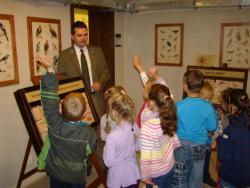 Centrum edukacyjne to miejsce zabaw i konkursów z wiedzy leśnej (foto. K.Polus)
Centrum edukacyjne to miejsce zabaw i konkursów z wiedzy leśnej (foto. K.Polus)
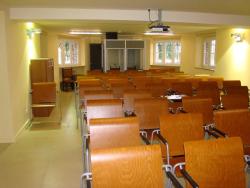 Centrum edukacji (foto K.Polus)
Centrum edukacji (foto K.Polus)
 Sala wystawiennicza (foto K.Polus)
Sala wystawiennicza (foto K.Polus)
 Dąb papieski posadzony z żołędzi poświęconych przez papieża Jana Pawła II (foto. K.Polus)
Dąb papieski posadzony z żołędzi poświęconych przez papieża Jana Pawła II (foto. K.Polus)
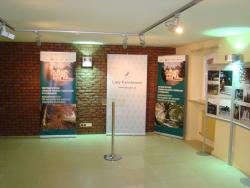 Sala wystawiennicza (foto K.Polus)
Sala wystawiennicza (foto K.Polus)
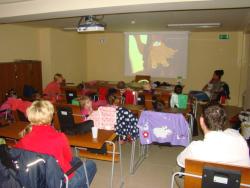 Kolejne kształcenie najmłodszych (foto.K.Polus)
Kolejne kształcenie najmłodszych (foto.K.Polus)
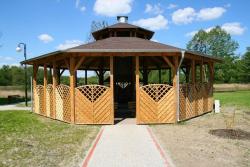 Wiata przy stawie i siedzibie Nadleśnictwa (foto.K.Polus)
Wiata przy stawie i siedzibie Nadleśnictwa (foto.K.Polus)
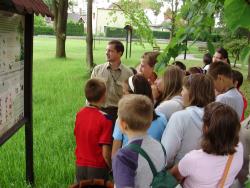 Ścieżka edukacyjna "Przy stawie" (foto.K.Polus)
Ścieżka edukacyjna "Przy stawie" (foto.K.Polus)
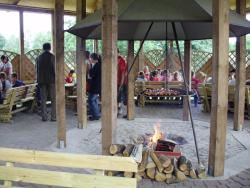 Wspólnie pod wiatą (foto.K.Polus)
Wspólnie pod wiatą (foto.K.Polus)
 Centrum edukacji (foto K.Polus)
Centrum edukacji (foto K.Polus)
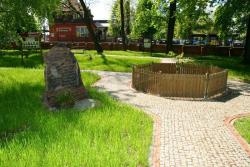 Dąb papieski w parku Nadleśnictwa (foto.K.Polus)
Dąb papieski w parku Nadleśnictwa (foto.K.Polus)
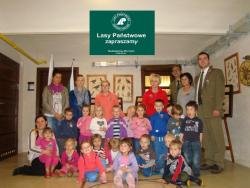 Podczas akcji "Zapraszamy" (foto.K.Polus)
Podczas akcji "Zapraszamy" (foto.K.Polus)
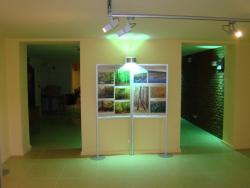 Sala wystawiennicza (foto K.Polus)
Sala wystawiennicza (foto K.Polus)
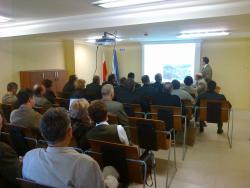 W trakcie szkolenia (foto K.Polus)
W trakcie szkolenia (foto K.Polus)
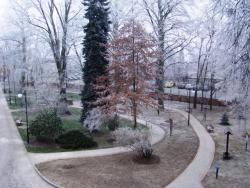 Park przy siedzibie Nadleśnictwa przy ul. Łąkowej 1 (foto.K.Polus)
Park przy siedzibie Nadleśnictwa przy ul. Łąkowej 1 (foto.K.Polus)
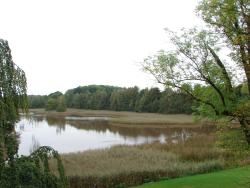 Widok na staw przy siedzibie N-ctwa (foto.K.Polus)
Widok na staw przy siedzibie N-ctwa (foto.K.Polus)
Foresters of the Forest District Wymiarki know how important it is nowadays to educate and develop social awareness, especially among children.
To shape the awareness, two educational trails were created, where one can have a nice time and learn basics of forest knowledge and forest work. All that, with benefit for one's health.
The educational trail "Przy Stawie" (By the pond) was opened in 2007 right next to the headquarters of the Forest District. The trail encompasses many educational boards presenting various forest-themed matters, a grand shelter and a wonderful garden with many trees and shrubs from our forest. Nearby, there is a pond, where many species of birds find shelter in the rushes. On the trail, there's also a place marked by stone plaque, where "Dąb papieski" (Papal oak) has been planted.
A two kilometre-long forest and education trail "Przy Wiacie" (by the shelter), located in the Wymiarki Forest Rangers Areas in a natural forest ecosystem. The trail starts at the road leading from Wymiarki to Lipna. You will find a shelter where you can rest here (photo no. 4). Fourteen themed stops have been organised on the trail leading through a beautiful old pine forest. Each of the stops presents information on forest ecosystems, forest management and the work of foresters aiming at protection and preservation of natural resources.
The sites are open all year round, Monday to Friday between 8.00 and 15.00. For availability outside opening hour, please call 0048 68-360-40-06.
Currently we are cooperating with Fundacja "Bory Dolnośląskie" foundation in creating horse riding trails. Because of educational tables and billboards placed in interesting spots around the Forest District, the trails will combine recreation with education.
Year in, year out the employees of the Forest District play an active role in developing the awareness of students from nearby primary schools by introducing the children to theoretical as well as practical parts of our work.
We organise forest-themed multimedia presentations and film screenings.
We invite you to see our forestry equipment shows.
We organise various competitions.
We believe that only through a good cooperation between Lasy Państwowe (State Forests) and the public, and through the right attitude of the society it is possible to achieve all the current goals of the Polish foresters.
 Asset Publisher
Asset Publisher
LEŚNE GEOFITY
LEŚNE GEOFITY
Tegoroczna wiosna klimatyczna czyli okres w którym średnie dobowe temperatury powietrza wahają się pomiędzy 5 a 15°C nastała wyjątkowo szybko. Efektem tego jest wiele kolorowych kobierców roślin porastających dno lasu.
Ciekawe kompozycje tworzą tzw. leśne geofity czyli rośliny, które wczesną wiosną możemy spotkać w buczynach, grądach lub dąbrowach. Geofity to byliny posiadające pączki odnawiające, które spędzają niekorzystny dla wegetacji okres roku w organach podziemnych takich jak bulwy, kłącza lub cebulki. Na terenie Nadleśnictwa Wymiarki pojawiły się fioletowo-niebieskie płaty porośnięte cebulicą dwulistną (Scilla bifolia). Widok kolorowych gron kwiatowych w drzewostanach bezlistnych, rozpoczynających dopiero wegetację stanowi ciekawą kompozycję barwną.
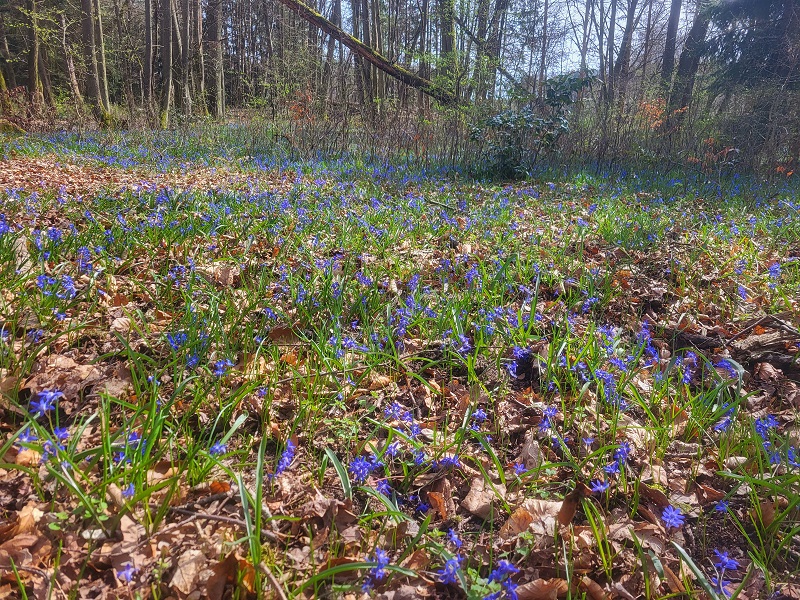
fot. Jakub Kazimir
Warto zwrócić uwagę na leśne geofity podczas leśnych wędrówek, zanim „zaginą” w późniejszej, bardziej bujnej roślinności. Wspomniana roślina jest gatunkiem charakterystycznym dla zbiorowiska roślinnych Querco-Fagetea czyli mezotroficznych i eutroficznych lasów liściastych zrzucających liście na zimę, rosnących na glebach mineralne o różnym stopniu wilgotności. Cebulica dwulistna kwitnie od marca do kwietnia. Jest samopylna lub zapylana przez owady. Ciekawostką jest tzw. myrmekochoria czyli roznoszenie nasion roślin przez mrówki, które gubiąc nasiona podczas transportu do mrowiska przyczyniają się do powiększania areału występowania danej rośliny. Obszar na którym występuje opisywana roślina to teren gdzie w okresie przed II wojną światową tętniło wiejskie życie, lecz osada nie dotrwała do czasów dzisiejszych. Należy również stwierdzić, że tak bujne kobierce występujące w roku bieżącym są efektem znikomej populacji dzika występującej na tym terenie, co stanowi skutek obecności ASF oraz redukcji populacji tego gatunku realizowanej przez myśliwych.


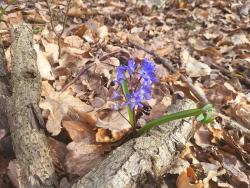 Cebulica dwulistna (fot. J.Karwański)
Cebulica dwulistna (fot. J.Karwański)
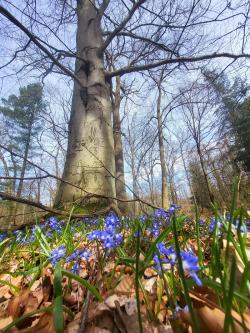 fot. Jakub Kazimir
fot. Jakub Kazimir
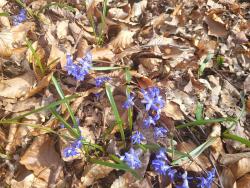 fot. J.Karwański
fot. J.Karwański



